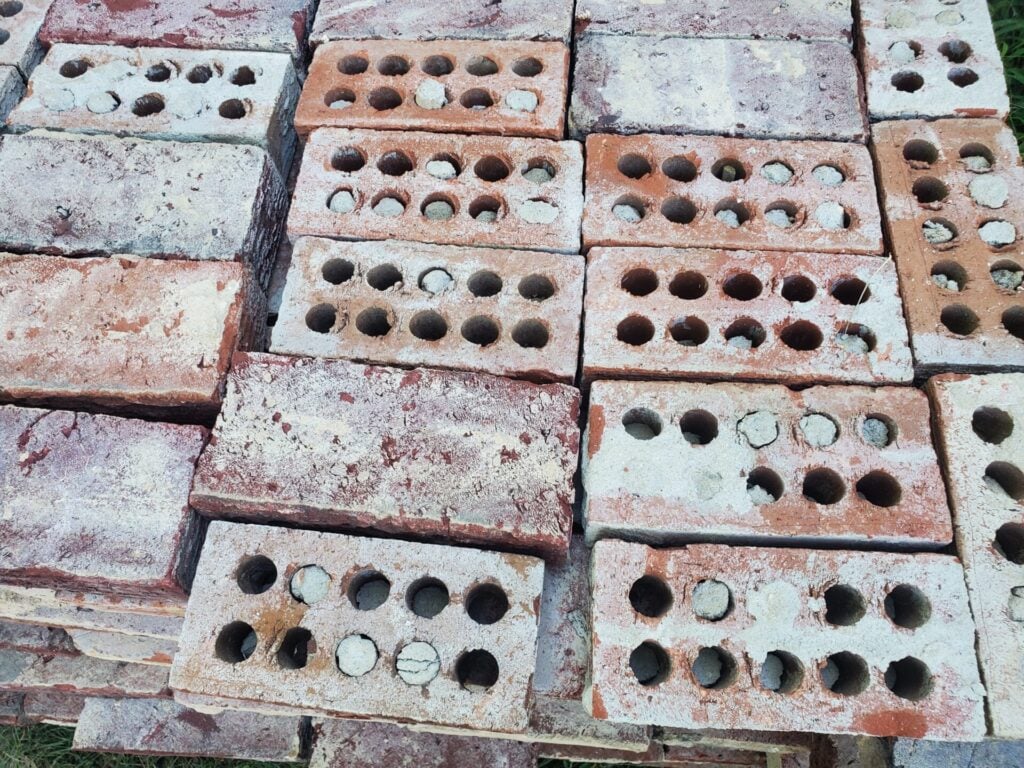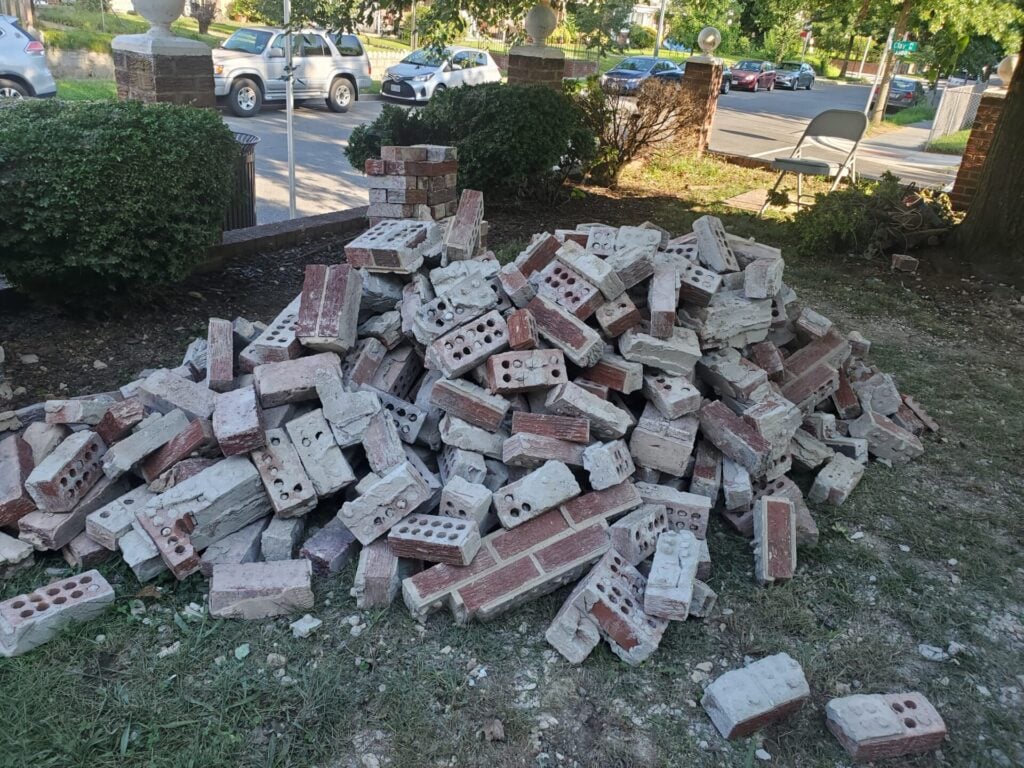A “fake brick” is actually a thing. You may have never heard of a fake brick but the term fake brick actually applies to more than one type of “brick”. It’s not the thing you normally think of when you think of a brick though, they are not really bricks by traditional standards, they don’t apply to typical historic masonry restoration and tuck pointing.
In historic times, fake bricks didn’t exist, as a mass manufactured product. Bricks then were pretty much all real without any exception, in scale. However, in historic buildings such as the row homes of Capitol Hill hill and historic neighborhoods of Washington DC there are often embellishments cast or set directly into the brick which are made from terracotta and not actually kiln fired clay. Terracotta is similar but can have more detail, such as a relief in the exposed face, and it is not the same as historic clay bricks. These elements are notable facade embellishments, replicating a stone carving, and add to the historic elegance and quality of historic buildings but often are almost missed or not recognized as pronounced details until processes of restoration and or historic brick tuck pointing or repointing. Like typical historic bricks, both pressed brick and the common brick, the terracotta elements are set in historic lime mortar. Historic lime mortar is a lower PSI and higher permeability binder, than modern mortar, by comparison.
The following list includes different types of bricks that are often referred to as being fake.
- Hollow bricks
- Veneer bricks
- Panel bricks
In recent times, in the post pandemic marketplace of the United States, large corporations have increased prices exorbitantly, just in an effort to increase profit at the expense of consumers. Builders as well feel the pinch as consumers with building supply houses and building owners are faced with increased pressures in the real estate market from rising interest rates. On the other side of the builder, they are faced with large scale corporate manufacturers who are increasing prices exorbitantly, just to increase their bottom line and profits without commensurate Increase of costs on their own end. In other places in the market,, throughout many industries, prices have increased significantly and customer service has actually diminished. In many ways, in many industries, consumers are paying more and getting less. Construction, by comparison, particularly in the restoration market is a little bit different because companies like ours who consider the customer / client relationship central to their competitive advantage and market focus specifically work to avoid diluting their values. The American Customer Service Satisfaction Index presents an interesting context with which you can examine the throughput or overall effect of service outcomes. The perception of satisfaction is at the cruz of that analysis. In other words, the setting of expectations it’s also related to the overall net output or measurement of customer service. In a direct way, perception is tied to a collective framework of values in building design and construction. Fake vs. real or authentic matters, at least to many people, especially here in DC. If nothing else, this in depth look into new products and technologies in the masonry sector of the building construction industry will help stakeholders, all of us invested in buildings or affected, take note and understand the subtle distinctions.
There are some applications, in certain contexts, where fake bricks may work better than real bricks for particular applications. Not all uses of fake bricks are intended just as cost savings, in fact, the material costs of some fake bricks are actually more than real bricks. All or these types of Hollow, Veneer, and Panel brick are relatively modern. The concepts of historic masonry construction, brick restoration, tuckpointing, repointing, and historic masonry preservation are generally unrelated to these new modern types of masonry and faux masonry.
Further details about the definition and history of the faux brick alternatives follow.
Hollow bricks
Hollow bricks first became commonly produced in the mid 20th century. The term “hollow” is sometimes used interchangeably but should be considered distinct from the term or classification of a “perforated” brick. Some organizations say the distinction may be at the amount of volumetric void in the brick: whereas between 1-25% void would be considered a hollow brick and between 25+-40% of volumetric void would be considered a perforated brick.
Hollow (modern) brick, aka perforated brick is brick that is not made for structural purposes. By comparison, almost all historic bricks were made for structural purposes. They comprised the walls, and most often the structural load path of the historic buildings we see today. That structural load path formed the superstructure of the building.
In the early 20th century, a new style of framing swept across America: California platform framing. This new style of framing, similar to it’s predecessor, balloon framing, allowed the structural load path of the building to be carried by uniformly produced or milled dimensional lumber.
As platform framing gained popularity, bricks became used for the first time, en masse as a new market and new technology, just as a facade skin. As the technology and building code changed, these new bricks alone did not require the same fire resistance capacity nor the same structural bearing capacity. To save costs of transportation, substrate material consumption, and loading capacity requirements, hollow bricks were created. Hollow bricks are similar in most ways but have a central portion removed through perforation which reduces the overall amount of materials and weight load of each brick.
In the image below, you can see examples of a hollow face brick that was removed from a 1930s building in northeast Washington, DC. In this particular example, an addition extension is being added to the side and front facades of the building. In this case, the demolished walls are being culled and cleaned to reuse and position the salvaged brick at the front facade. But, in this unique circumstance, the salvaged brick was a hollow brick, used as an addition done or completed in previous years.
If you look closely at this brick, you can see that some of the perforation holes in the brick, 12 per brick, are filled with mortar from the bed joints. In this case, one of the few advantages of a hollow brick is that, like a brick with a frog, the perforations creates a key for better cohesion of the brick which therein creates better lateral structural strength and lateral deflection resistance.
As a side note, the pile of brick, being dismantled and cleaned, to remove mortar at the head and bed facings of the brick, is shown below. This is an arduous and tedious task, very laborious and costly in the Washington, DC market.
Interestingly, specific to the salvage materials market in Washington DC, on the 10th of August, 2022, Community Forklift, a long standing salvage yard and non-profit institution in the Washington DC metropolitan, announced that they would be losing their facility’s land lease from Washington Gas and would have to relocate. Many of the Washington DC residents are sad to hear this news but hopeful that Community Forklift will have a new home soon.
The following description is from Community Forklift’s website www.communityforklift.com
Community Forklift is the DC area’s hometown salvage yard. We pick up donations throughout the DC region, then offer those items to the public in our 40,000 square foot warehouse. Shoppers marvel at the thousands of unique vintage items, reclaimed wood, door and window selection, lighting, bath fixtures, tile, furniture, appliances, hardware, tools, bricks, marble and granite, and much, much more. Visit us seven days a week to shop or drop off donations at 4671 Tanglewood Dr., Edmonston, MD 20781 (five minutes from DC). Community Forklift’s name refers to our mission: to lift up local communities through reuse. When you shop or donate, you’re helping us make repairs affordable, reduce waste, promote reuse, and create green jobs.
To properly maintain, repair, and care for these historic buildings, a knowledge, interest and understanding of historic building principles is required. Here in Washington DC, historic masonry buildings are extremely expensive and the amount of financial loss caused by improper repointing and low quality construction is staggering. However, in addition to the direct financial value of the property, there is also a cultural loss when historic buildings are damaged. By comparison, consider neighboring poor cities, when historic buildings are damaged, it’s not just the loss of value to the property owner, there’s also a loss to all inhabitants and visitors of a city, present and future, who care about architecture, history, and culture.
We encourage all of our clients, and all readers of this article and to our blog in general, to prioritize the historic built environment of Washington DC and neighborhoods such as Capitol Hill, Dupont Circle, and Georgetown and become educated on on the difference between proper historic preservation versus improper work which leads to significant damage to the historic fabric of a building.
From a conservation and preservation perspective, several approaches can be taken to improve conditions related to deteriorated historic brick masonry. Primarily, lime mortar brick joints and low temperature fired soft red clay bricks should be inspected and checked on a routine maintenance schedule, either seasonally or at least annually. If brick masonry is kept in good condition, the life of embedded wood elements can be significantly extended. Hire a professional contractor which specializes, understands and appreciates historic construction elements and buildings.
In this article we talked about the terminology and concepts of historic masonry restoration, follow the links below for more related information from the IDS website:
- Binders in mortars and concrete
- Brick burns
- Butter joint
- Capillary action
- Cantilever
- Cementitious siding
- Cheek wall, masonry — Draft
- Chemical testing
- Code, building — Draft
- Cold joint
- Cold weather masonry work — Draft
- Damp proof course
- Downspout
- Electrical distribution panel — Draft
- Fenestration
- Ferrous metals
- Great Chicago Fire
- Green bricks
- Gutter, roof
- Lime mortar
- Lintel
- Load path
- Oriel window
- Oxidation
- Parapet coping
- Plug, clay
- Pressed bricks
- Raking, of mortar joints
- Raggle, aka reglet
- Rectilinear
- Roman bricks
- Roman arches
- Roof eave
- Roof termination
- Row buildings and row homes
-
- Rubbed bricks
- Rubble stone masonry
- Sand, Builder’s
- Sedimentary rock
- Scratch coat
- Sprung arch
-
- Squint bricks,
- Strike, or striking of mortar
- Tapestry bricks
- Tooth-in, interlocking masonry connections
- Vitreous
- Water diversion systems
- Zipper-joint
These concepts are part of the fundamentals of historic masonry restoration, tuckpointing, and brick repair.
The links in the list above will take you to other articles with more information on defects, failures, preservation and repair of historic masonry. You can learn a lot more on our blog. Feel free to check it out. If you have questions about the historic masonry of your building in Washington DC, fill out the webform below and drop us a line. We will be in touch if we can help.



